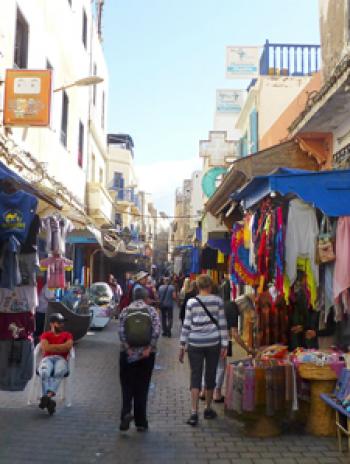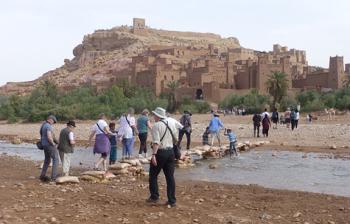Morocco in depth (First of three parts)
This item appears on page 43 of the July 2019 issue.
In April 2019 I ventured to exotic Morocco with the hope of finding a balance between discovering its historic, cultural and natural world attractions and finding the on-the-ground pulse of the country today.
I found a land of contradictions, often difficult if not impossible to define. Moroccans today appear to live with a tug-of-war of values between the often polar-opposite, if not polarizing, influences of East and West. One example of this was style of dress, which was more traditional and conservative than I had anticipated, especially among women.
One of North Africa’s most stable countries, Morocco is more prosperous and more diverse in terms of culture and economy than its contiguous neighbors. With a future seemingly pointed in a positive direction, it’s led by a highly popular King, Mohammed VI, whose image seems to be displayed everywhere.
There are also rather opulent royal palaces in many locations, although it was explained that most are not actually owned by the monarchy.
The country is not without problems, as poverty, illiteracy, corruption and, in particular, youth unemployment present ongoing challenges.
My pre-trip research indicated that it is wise for first-time visitors to Morocco to leave all preconceptions behind. This advice proved to be golden, as by the end of my 18-day sojourn, I had fully accepted that Morocco is more a place to simply be experienced than to actually be understood, especially through Western filters.
On my hosted journey with Toronto-based ElderTreks (Toronto, ON; 800/741-7956, www.eldertreks.com), I was in the company of 16 very savvy, worldly travelers: 11 Canadians and five Americans. With the help of our highly experienced Moroccan trip guide, Samir Harit, we set out to unravel some of the mysteries surrounding this timeless piece of North African real estate.
The primary reason I chose this particular tour is it covered more of Morocco than did the shorter itineraries offered by most tour companies. I wanted to be able to, at least at times, escape the traditional-tourist-circuit hordes, and our longer, more comprehensive journey proved to be largely successful in that regard.
In-depth Morocco circuit
Beginning and finishing in Morocco’s largest city, Casablanca (pop. 3.4 million), our routing took us north along the heavily populated Atlantic coastline to Rabat, the political capital. Turning eastward and inland, we traveled to the Roman ruins at Volubilis for a night in a hillside hotel overlooking the site before continuing on via Meknes the next day to Fez, where we stayed two nights.
A long road trip southward through the Middle Atlas Mountains took us to Erfoud, a gateway to the Sahara. After a night at Merzouga followed by a night in a desert tented camp, we trekked westward to the Todra Gorge, Ouarzazate and Taroudant, with one night in each location.
Continuing south, we ventured off the beaten track through the Anti-Atlas Mountains to isolated Tafraout for a 2-night stay before doing an about-face northward, briefly visiting the coastal city of Agadir and having two nights on the beachfront at Essaouira.
Maneuvering east again, we arrived in exciting Marrakech, again staying two nights before completing our Morocco circuit by heading north to Casablanca for a final night.
What made our several lengthy road trips palatable was a very comfortable, nearly new, 26-seat coach with onboard Wi-Fi, which, as a bonus, actually worked most of the time.
ElderTreks offers their “Morocco – Kasbahs, Berbers & the Sahara” tour in April and October each year, as spring and fall departures help ensure mild traveling temperatures, even in the mountains, and avoid the temperature extremes of the summer and winter seasons.
During our April tour, daytime temperatures were generally in the 60s (Fahrenheit), with nighttime lows in the high 40s to low 50s. I considered these to be ideal traveling temperatures, but there were some tradeoffs.
I am an avid swimmer, and while all of our hotels except one had swimming pools, the April water temperatures were such that I swam only twice. The ocean conditions in our two beach areas, Casablanca and Essaouira, seemed a bit pre-season, with only a few young locals braving the surf.
Cuisine experiences
With all of the meals being provided on this tour, we were essentially steeped in Moroccan cuisine for 17 days, traditional tagine fare taking center stage most days. Tagine cuisine generally combines meats or poultry with vegetables, starches and even certain fruits, all baked and stewed in earthenware dishes with conical lids.
The tagine was typically complemented with brochettes and kebobs of meat and poultry. Beef, chicken, lamb and goat tagines took turns gracing our table, revealing a complex labyrinth of subtleties in terms of spice and taste. There seemed to be few tagine cooking rules; the culinary influences of Arabs, desert nomads, the French and Southern Europeans all were present.
Most Moroccans rarely eat out, believing the best food is found with home cooking. I credit Samir for finding many special restaurants serving authentic Moroccan cuisine during our city visits. Many of these were in historic buildings hidden in the backstreets of medinas, the old Arab or non-European quarters in North African towns. Most of the medinas were located within ancient city walls that somehow have survived the ravages of time.
On a few occasions, the dining setting was so unique, it captured more of our attention than the meal itself.
An agricultural mecca
To my surprise, much of Morocco was something of an agricultural mecca. Throughout our travels, including in some of the four mountain ranges traversed, we discovered field crops and orchards in abundance.
Morocco’s climate is generally friendly toward producing a wide range of crops, particularly citrus fruits, nuts and vegetables. Groves of orange, olive and almond trees were complemented by strange and exotic species such as argan.
I was unable to resist buying some of the local “fountain of youth” products touting medicinal as well as cosmetic benefits, such as difficult-to-extract oils from prickly pears, fig seeds and the highly promoted argan.
We also encountered vineyards, and our wine-oriented group enjoyed inexpensive but very drinkable Moroccan wines with most of our meals.
Having set the stage, next month I will share some of the experiences from the first half of our exploration of Morocco.
Contact Randy at 80 America Way, Jamestown, RI 02835; 401/560-0350, randykeck@yahoo.com.


